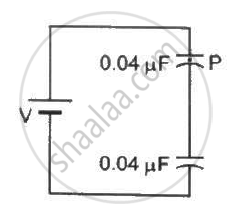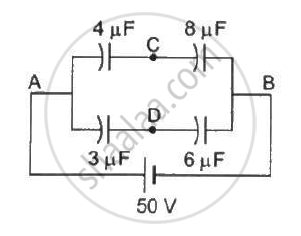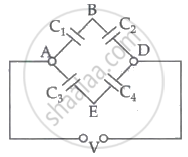Advertisements
Advertisements
Question
The particle P shown in figure has a mass of 10 mg and a charge of −0⋅01 µC. Each plate has a surface area 100 cm2 on one side. What potential difference V should be applied to the combination to hold the particle P in equilibrium?

Solution
The particle is balanced when the electrical force on it is balanced by its weight.
Thus,
`mg = qE`
`mg = q xx V^'/d.............(1)`
Here,
d = Separation between the plates of the capacitor
V' = Potential difference across the capacitor containing the particle
We know that the capacitance of a capacitor is given by
`C = (∈_0A)/d`
`⇒ d = (∈_0A)/c`
Thus, eq. (1) becomes
`mg = q xx V^' xx C/(∈_0A)`
`⇒ V^' = (mg∈_0A)/(q xx c)`
`⇒ V^' = (10^-6 xx 9.8 xx (8.85 xx 10^-12) xx (100 xx 10^-4))/((0.01 xx 10^-6) xx (0.04 xx 10^-6)`
`⇒ V^' = 21.68 "mV"`
Since the values of both the capacitors are the same,
`V = 2V = 2 xx 21.86 ≈ 43 "mV"`
APPEARS IN
RELATED QUESTIONS
A point charge +Q is placed at point O, as shown in the figure. Is the potential difference VA – VB positive, negative or zero?

Take the potential of the point B in figure to be zero. (a) Find the potentials at the points C and D. (b) If a capacitor is connected between C and D, what charge will appear on this capacitor?

Answer the following question.
The magnitude of the electric field (in NC – 1) in a region varies with the distance r(in m) as
E = 10r + 5
By how much does the electric potential increase in moving from point at r = 11 m to a point at r = 10 m.
Electric potential energy of two point charges q and q0 is ________.
If a positive charge moves opposite to the direction of the electric field, the field does _______ work on charge and potential energy ________.
It becomes possible to define potential at a point in an electric field because electric field ______.
A cube of metal is given a positive charge Q. For this system, which of the following statements is true?
From a point charge, there is a fixed point A. At A, there is an electric field of 500 V/m and potential difference of 3000 V. Distance between point charge and A will be ______.
A positively charged particle is released from rest in a uniform electric field. The electric potential energy of the charge ______.
-
The metal plate divides the capacitor into two capacitors connected in parallel to each other.
-
The metal plate divides the capacitors into two capacitors connected in series with each other.
-
The metal plate is equivalent to a dielectric of zero dielectric constant.
An electric dipole of moment `vec"p"` is placed in a uniform electric field `vec"E"`. Then ______.
- the torque on the dipole is `vec"p" xx vex"E"`
- the potential energy of the system is `vec"p" * vec"E"`
- the resultant force on the dipole is zero.
Choose the correct option.
If a conductor has a potential V ≠ 0 and there are no charges anywhere else outside, then ______.
The force acting on a particle in one dimension is F = ax - 2xβ3. The corresponding potential energy V(x), assuming V(0) = 0 is given by ______.
If a conductor has a potential V ≠ 0 and there are no charges anywhere else outside, then ______.
- there must be charges on the surface or inside itself.
- there cannot be any charge in the body of the conductor.
- there must be charges only on the surface.
- there must be charges inside the surface.
The electric potential on the axis of an electric dipole at a distance ‘r from it’s centre is V. Then the potential at a point at the same distance on its equatorial line will be ______.
The potential difference between points B and E of the circuits is ______.

